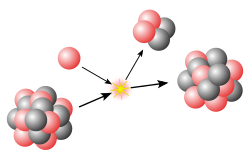| Nuclear physics |
|---|
 |

In nuclear physics, an atomic nucleus is called a halo nucleus or is said to have a nuclear halo when it has a core nucleus surrounded by a "halo" of orbiting protons or neutrons, which makes the radius of the nucleus appreciably larger than that predicted by the liquid drop model. Halo nuclei form at the extreme edges of the table of nuclides — the neutron drip line and proton drip line — and have short half-lives, measured in milliseconds. These nuclei are studied shortly after their formation in an ion beam.
Contents
Typically, an atomic nucleus is a tightly bound group of protons and neutrons. However, in some nuclides, there is an overabundance of one species of nucleon. In some of these cases, a nuclear core and a halo will form.
Often, this property may be detected in scattering experiments, which show the nucleus to be much larger than the otherwise expected value. Normally, the cross-section (corresponding to the classical radius) of the nucleus is proportional to the cube root of its mass, as would be the case for a sphere of constant density. Specifically, for a nucleus of mass number A, the radius r is (approximately)
where is 1.2 fm.
One example of a halo nucleus is 11 Li, which has a half-life of 8.6 ms. It contains a core of 3 protons and 6 neutrons, and a halo of two independent and loosely bound neutrons. It decays into 11 Be by the emission of an antineutrino and an electron. [1] Its mass radius of 3.16 fm is close to that of 32 S or, even more impressively, of 208 Pb, both much heavier nuclei. [2]
Experimental confirmation of nuclear halos is recent and ongoing. Additional candidates are suspected. Several nuclides including 9B, 13N, and 15N are calculated to have a halo in the excited state but not in the ground state. [3]

